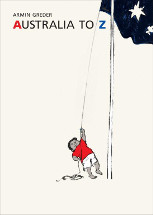Australia to Z by Armin Greder

Allen & Unwin, 2016. ISBN 9781760113186
(Age: all) Highly recommended. Australia, Racism, Icons. The image
of the globe with a magnifying glass being held over the continent
of Australia, warns us that this is not the usual A-Z of Australia,
with its koalas and Opera House but an acerbic positioning, a
sharper view of the cultural icons of Australia. And with these
cultural symbols under such a spotlight we are forced to look at
them in a different way, to look at things we hold dear with
questioning eyes.
Greder uses his black edged illustrative technique to great effect,
making many images standing out against the white background, with
seemingly few deft strokes encompassing all that needs to be said.
The first two, A and B herald the tone of the book, as A is
Aborigine showing a lone figure standing on the headland watching
the approach of a sailing ship, and B is Boat People, with a small
boat of refugees crossing the expansive ocean. What a contrast. Two
different groups of people approaching Australia for quite different
reasons. And anyone seeing these images will question Australia's
attitude to the three groups today.
To point out only a few amongst the smorgasbord of razor edged
images is difficult. Many made me stop in my tracks, N, Nationalism
shows a large, booted male individual caped in an Australian flag,
reminiscent of the Cronulla riots ten years ago, and R, Rupert shows
the eyeless man whose influence over the land of his birth seems
never ending.
No matter what the image created, each impels the reader to think
more about what is shown, from Yakka for hard work, Vegemite with a
child eating the stuff that visitors are always enjoined to try,
Waltzing Matilda, with the swaggie' s hat in the middle of the
billabong. Several are laugh out loud, Esky, Gold Coast, Ikea, for
example, while others bring a lump to the throat, Digger, Pokies,
Kangaroo.
A mirror is held up to our society, pointing out things about us
which are hard to digest, but necessarily need to be discussed,
especially when our National Anthem forms an appendix underlining
the difference between some of our icons and the words we sing at
occasions of importance. We all know the words parrot fashion, but
reading them shows the divide between what we sing and what actually
happens.
This is a brilliant piece of theatre, one which classes can unpick,
discuss and debate, looking at the icons presented from a fresh
perspective, reading our national anthem with greater care, and
pondering how we can be changed for the better.
Fran Knight